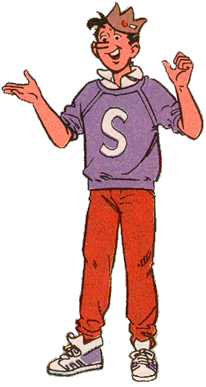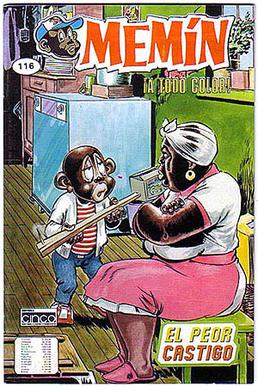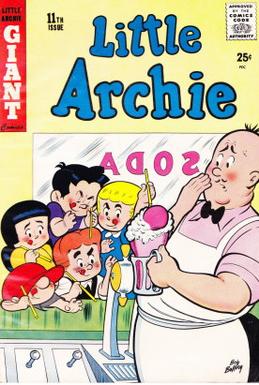
Forsythe Pendleton "Jughead" Jones III is one of the fictional characters created by Bob Montana and John L. Goldwater in Archie Comics who first appeared in the first Archie story, from Pep Comics #22. He is the drummer of the Archies and is a son of Forsythe Pendleton Jones II; in one of the early Archie newspaper comic strips, he is identified as John Jugworth Jones III. He has a white sheepdog named Hot Dog and a younger sister, Forsythia "Jellybean" Jones.

Memín Pinguín was a Mexican comic book character. He was created in 1943 by writer Yolanda Vargas Dulché. Alberto Cabrera took over drawing from 1953 until 1962, followed by Sixto Valencia Burgos.

Just William is the first book of children's short stories about the young school boy William Brown, written by Richmal Crompton, and published in 1922. The book was the first in the series of William Brown books which was the basis for numerous television series, films and radio adaptations. Just William is also sometimes used as a title for the series of books as a whole, and is also the name of various television, film and radio adaptations of the books. The William stories first appeared in Home magazine and Happy Mag.

Little Lulu is a comic strip created in 1935 by American author Marjorie Henderson Buell. The character, Lulu Moppet, debuted in The Saturday Evening Post on February 23, 1935, in a single panel, appearing as a flower girl at a wedding and mischievously strewing the aisle with banana peels. Little Lulu replaced Carl Anderson's Henry, which had been picked up for distribution by King Features Syndicate. The Little Lulu panel continued to run weekly in The Saturday Evening Post until December 30, 1944.

Little Archie is a comic book published by Archie Comics from 1956 to 1983, lasting 180 issues. Little Archie #1 is considered to be "scarce" by the Overstreet Comic Book Price Guide. Among the artists and writers who drew the series were Bob Bolling and Dexter Taylor
This is a list of various alternate universes featuring characters from Archie Comics. Most Archie stories take place within a setting that is gradually updated over the years, and events in one stories are not commonly referenced in others, but those stories remain largely in continuity with each other. However, there have been several series of stories that take place outside of this continuity, featuring alternate versions of the characters in different settings.

Tinkle is an Indian weekly magazine for children in English, published from Mumbai. Originally owned by the India Book House, the Tinkle brand was acquired by ACK Media in 2007. The magazine contains comics, stories, puzzles, quizzes, contests and other features targeted at school children, although its readership includes many adults as well. It is published in English and syndicated in many Indian languages like Hindi, Bengali, and Malayalam.

Since Scouting began in 1907, it has entered into many elements of popular culture, including movies, TV and books.

Titeuf is a French comic series created by the Swiss comic-book creator Zep in 1992. In 2001 it was adapted into an animated TV series and in 2011 into a film with the same title. The series also appears in the Franco-Belgian comics magazine Tchô!.

Tina's Pals is a Brazilian comic strip series, part of the Monica's Gang series, created in 1970. The stories are aimed at a more teenage group of readers, rather than the kids who would read other Mauricio de Sousa's works and thus center around teenagers and young adults. However, Mauricio prefers not to mention drugs, topics about sexuality, or other similar subjects, which are very popular among teenagers. Instead, the strips are written with themes related to school or university, dating, problems with parents, etc.

Monica is a Brazilian fictional character and Mauricio de Sousa's best-known creation. Introduced in 1960, she serves as the main protagonist and title character of the Monica and Friends comic book series and media franchise.
Archie's Mad House was a comic book magazine published by Archie Comics from 1959 to 1982. The series went through a number of overhauls and name changes. Classic stories have occasionally appeared in digest magazines.

Life with Archie is a comic book published by Archie comics from 1958 to 1991. It featured Archie Andrews in adventure stories that were more dramatic than the standard Archie tales. In 2010, it was revived as a magazine-sized comic devoted to stories that grew out of Archie Marries Veronica/Archie Marries Betty. Archie's character was killed in the second to last issue, Life with Archie #36.

La Ribambelle is a Belgian comics series about a gang of kids living in the same neighbourhood. There were two versions of this strip: Joseph Loeckx drew a one-off story in 1958, but the longer-lasting version was that of Jean Roba who created a whole new set of characters who came from various countries and ethnic backgrounds but lived in the same city. They played in a local yard and even had adventures abroad. Others who contributed to the strip included writers Vicq, Maurice Tillieux and artist Jidéhem.
Although, traditionally, female comics creators have long been a minority in the industry, they have made a notable impact since the very beginning, and more and more female artists are getting recognition along with the maturing of the medium. Women creators have worked in every genre, from superheroes to romance, westerns to war, crime to horror.

O Menino Maluquinho is a children's media franchise created by the Brazilian writer and cartoonist Ziraldo in the 80s. It started as a children's book published in 1980 which for many years was regarded as a classic of children's literature in Brazil, getting spun off into comics, movies, plays and TV series, as well being known for being Ziraldo's longest running comic book series and the second most popular, after "Turma do Pererê".

June was a British weekly girls' comic anthology published by Fleetway Publications and IPC Magazines from 18 March 1961 to 15 June 1974. Designed as a response to DC Thomson's hit Bunty, June never quite eclipsed its Scottish rival but was nevertheless a success on its own terms, reaching 631 issues before being merged into Tammy in 1974.

Pelezinho is a Brazilian comic book series created by Mauricio de Sousa based on soccer star Pelé in his childhood. The character was created in 1976 from conversations between Mauricio and Pelé to create a character to better promote the player who at the time had just become a phenomenon for the Brazil national team. The characters were suggested by Pelé himself, based on childhood memories.
















